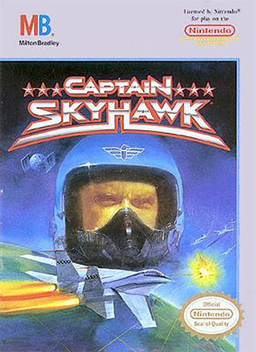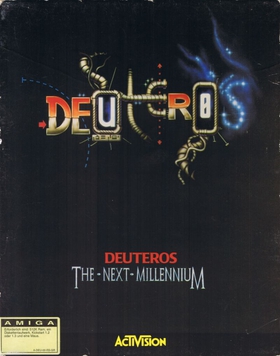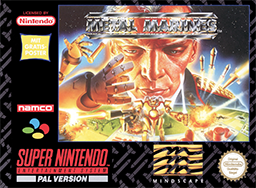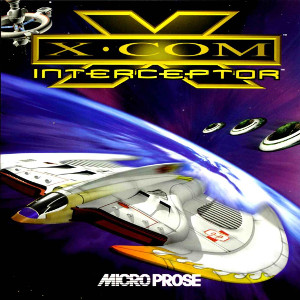
The Berserker series is a series of space opera science fiction short stories and novels by Fred Saberhagen, in which robotic self-replicating machines strive to destroy all life.

Missile Command is a 1980 shoot 'em up arcade video game developed and published by Atari, Inc. and licensed to Sega for Japanese and European releases. It was designed by Dave Theurer, who also designed Atari's vector graphics game Tempest from the same year. The game was released during the Cold War, and the player uses a trackball to defend six cities from intercontinental ballistic missiles by launching anti-ballistic missiles from three bases.

Captain Skyhawk is a scrolling shooter video game developed by Rare and published by Milton Bradley Company. The game was released in North America in June 1990 and in Europe the next year for the NES. It was also released for the PlayChoice-10 arcade machine.

Deuteros: The Next Millennium is the sequel to the sci-fi strategy video game Millennium 2.2, published by Activision for the Amiga and Atari ST. Ian Bird designed and wrote the game, with graphics by Jai Redman and music by Matt Bates.

Earth 2150: The Moon Project is a sequel to the real time strategy game Earth 2150. While the game is in fact a stand-alone game, many consider it an expansion pack because it does little more than provide new missions, and weapons. The story takes place alongside the original game's story. The Moon Project was released in 2000 by Strategic Simulations, Inc.
Renegade Legion is a series of science fiction games that were designed by Sam Lewis, produced by FASA, and published from 1989 to 1993. The line was then licensed to Nightshift games, a spin-off of the garage company Crunchy Frog Enterprises by Paul Arden Lidberg, which published one scenario book, a gaming aid, and three issues of a fanzine-quality periodical before reverting the license.

Earth 2140 is a 2D real-time strategy computer game created in 1997 by Polish-based Reality Pump Studios and published by TopWare Interactive. It has two sequels, Earth 2150 and Earth 2160.

Metal Marines is a real-time strategy video game developed by Namco for the Super Nintendo Entertainment System. It was ported to Microsoft Windows PCs by Mindscape. It was later released in Japan under the title of Militia. The Super NES version was re-released on the Virtual Console in Japan on July 10, 2007, for the Wii and on March 4, 2015, for the Wii U, and in North America on October 15, 2007, for the Wii.

Space weapons are weapons used in space warfare. They include weapons that can attack space systems in orbit, attack targets on the earth from space or disable missiles travelling through space. In the course of the militarisation of space, such weapons were developed mainly by the contesting superpowers during the Cold War, and some remain under development today. Space weapons are also a central theme in military science fiction and sci-fi video games.

Raid Over Moscow is a video game by Access Software published in Europe by U.S. Gold for the Commodore 64 in 1984 and other microcomputers in 1985-1986.

Shattered Steel is a mech simulation game developed by BioWare and published by Interplay Productions for MS-DOS in 1996. It was later ported to Mac OS by now-defunct Logicware. It is notable for the deformable terrain effects, and for being BioWare's first developed game.

The militarisation of space involves the placement and development of weaponry and military technology in outer space. The early exploration of space in the mid-20th century had, in part, a military motivation, as the United States and the Soviet Union used it as an opportunity to demonstrate ballistic-missile technology and other technologies having the potential for military application. Outer space has since been used as an operating location for military spacecraft such as imaging and communications satellites, and some ballistic missiles pass through outer space during their flight. As of 2018, known deployments of weapons stationed in space include only the Almaz space-station armament and pistols such as the TP-82 Cosmonaut survival pistol.
A kinetic bombardment or a kinetic orbital strike is the hypothetical act of attacking a planetary surface with an inert kinetic projectile from orbit, where the destructive power comes from the kinetic energy of the projectile impacting at very high speeds. The concept originated during the Cold War.

Metal Gear are the mecha in the Metal Gear series. In the series, a Metal Gear is a bipedal nuclear weapons-equipped tank. The Metal Gears are typically autonomous nuclear launch platforms which the player must destroy to save the world and complete the game. Often, confronting the latest Metal Gear model is one of the final challenges of each game.

X-COM: Interceptor is the fourth main game in the X-COM series, developed by MicroProse's Chapel Hill development studio and released in 1998. The game is a combination of many genres, including space flight simulation, business simulation game and strategy game elements. More specifically, the player's role includes managing a number of X-COM space stations, piloting starfighters during hostile encounters whilst co-ordinating wingmen, and managing resources and research. X-COM Interceptor, although released as the fourth game, is actually set before X-COM: Apocalypse, thus making it the third game in the chronological order. The game was re-released in 2008 for Steam and GamersGate, and again in 2016 on GOG.com.

Dancouga Nova – Super God Beast Armor is a Super Robot anime television series, produced by Ashi Productions and is directed by Masami Ōbari, who was also in charge of mechanical design. The series is supposedly a follow-up of its predecessor, Dancouga – Super Beast Machine God. The series premiered across Japan on the Japanese CS television network Animax, and also KBS Kyoto on 15 February 2007, spanning a total of 12 episodes.

Tom Clancy's H.A.W.X. 2 is an arcade-style combat flight simulator video game developed by Ubisoft Bucharest and published by Ubisoft. It is the sequel to Tom Clancy's H.A.W.X, and was released for Xbox 360 and PlayStation 3 in September 2010, and for Wii and Microsoft Windows in November 2010.

Land Air Sea Warfare is a real-time strategy game developed by Isotope 244. It is the sequel to Machines at War and the predecessor of Machines at War 3. LASW was released in 2010 for Microsoft Windows, Android, Mac OS X, iOS and Windows Mobile. It features gameplay similar to other RTS titles like Command & Conquer: Red Alert, Age of Empires, StarCraft, Warcraft, and Supreme Commander. The game was ported to Ouya in 2015.
Robocraft is an online vehicular combat game developed and published by Freejam Games. The game is set on different planets, with players constructing robots to fight with and against others in battle. The game features contained garage bays in which players can build various functional vehicles with basic block-based parts, such as cubes and wheels, along with weapons that can be used for combat. The initial alpha build was released in March 2013, and gained over 300,000 players by the following year. It officially released out of beta on August 24, 2017.
















